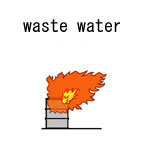| Case Name |
Fire caused due to flammable iron sulfide generated in a drainage tank of an oil refinery |
| Pictograph |

|
| Date |
April 15, 1995 |
| Place |
Kawasaki, Kanagawa, Japan |
| Location |
Refinery |
| Overview |
During a periodic overhaul of waste water treatment facilities in the refinery, the upper part of the manhole of the waste water tank was fully opened. Deflagration took place when the lid of the side manhole was pulled up. Flammable iron sulfide generated in the manhole as well as in the tank ignited on opening the manhole, and hydrogen sulfide generated also caught fire and spouted from the side manhole. A number of workers got burnt. |
| Incident |
During a periodic overhaul of waste water treatment facilities in a refinery, the upper manhole of the waste water tank was fully opened. Deflagration occurred when another manhole in the side wall was opened. Refer to Fig2. |
| Processing |
Manufacture |
| Individual Process |
Maintenance |
| Substance |
Waste water |
| Type of Accident |
Fire |
| Sequence |
To clean the waste water tank of the waste water treatment facility, the upper manhole was opened. The lid of the side manhole was pulled up to check the quantity of residual liquid inside, and then it was returned to its original position, but still un-tightened by bolts. After the sound of a blowout, flames spouted from the side manhole within seconds. |
| Cause |
Flammable iron sulfide that was generated in the tank ignited on opening the manhole, hydrogen sulfide generated also caught fire and spouted from the manhole. There was iron sulfide in the tank, not only inside the manhole, which ignited when the air came in on opening the manhole. |
| Countermeasures |
1. The manual for opening procedure was prepared.
2. Sludge containing iron sulfide should be removed by water jet operation at the time of inspection. |
| Knowledge Comment |
In a wet system with the existence of sulfur and hydrogen sulfide being predicted, it is important to study of hazards related to ignition, combustion, and generation of hydrogen sulfide in the presence of sulfur in advance. Maintenance of closed areas requires prior study of materials inside including lack of oxygen. |
| Background |
The waste water contained hydrogen sulfide which generated flammable iron sulfide using water and iron (tank material) available there. It ignited as air came into the tank on opening it; hydrogen sulfide in the tank also caught fire and flames spouted from the manhole. Components of air in the tank had not been studied by a document review or gas detection tests. The drain water dissolved various chemical substances that made contact in the various processes. These substances caused various chemical reactions in the tank, and were sometimes vaporized into the air. These hazards were not understood. |
| Incidental Discussion |
The waste water tank is dangerous. Waste water is a mixture of various dissolved hydrocarbons, chemicals, and sulfur. |
| Reason for Adding to DB |
Example of typical fire accident caused due to failure to predict the generation of ignitable substances |
| Scenario |
| Primary Scenario
|
Poor Value Perception, Poor Safety Awareness, Inadequate Risk Recognition, Ignorance, Insufficient Knowledge, Insuficient Experience, Usage, Disposal, Separation of Gas from Waste Water, Planning and Design, Poor Planning, Poor Planningof Tank Opening to Atmosphere, Bad Event, Chemical Phenomenon, Burning, Secondary Damage, External Damage, Fire, Bodily Harm, Injury, 6 peson injured
|
|
| Sources |
High Pressure Gas Safety Inst. of Japan. High pressure gas protection overview. p.264-(1996).
Kawasaki City Fire fighting station Prevention division, Peace section. Fire of waste water treatment facility in To petroleum Co., Ltd., K refinery. Material of the Kawasaki City Complex safety countermeasure committee. (1995)
Fire and Disaster Management Agency. Main accident case. Drainage tank fire Accident case of dangerous material. pp.255,276-277
|
| Number of Injuries |
6 |
| Physical Damage |
Rolls of sheet metal and waterproof sheets were damaged by fire. Paint of a tank, about a five-square meter wall of the control room, and devices and materials for heat insulation work were also partially damaged by fire. |
| Financial Cost |
About ¥ 3,000,000 (Accident examples of dangerous material) |
| Multimedia Files |
Fig2.Flow chart of tank environment
|
| Field |
Chemicals and Plants
|
| Author |
WAKAKURA, Masahide (Kanagawa Industrial Technology Research Institute)
TAMURA, Masamitsu (Center for Risk Management and Safety Sciences, Yokohama National University)
|